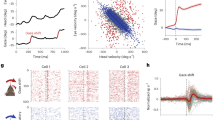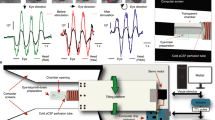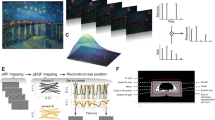Abstract
High-level circuits in the brain that control the direction of gaze are intimately linked with the control of visual spatial attention1,2,3,4,5. Immediately before an animal directs its gaze towards a stimulus, both psychophysical sensitivity to that visual stimulus and the responsiveness of high-order neurons in the cerebral cortex that represent the stimulus increase dramatically3,6,7. Equivalent effects on behavioural sensitivity and neuronal responsiveness to visual stimuli result from focal electrical microstimulation of gaze control centres in monkeys8,9,10,11. Whether the gaze control system modulates neuronal responsiveness in sensory modalities other than vision is unknown. Here we show that electrical microstimulation applied to gaze control circuitry in the forebrain of barn owls regulates the gain of midbrain auditory responses in an attention-like manner. When the forebrain circuit was activated, midbrain responses to auditory stimuli at the location encoded by the forebrain site were enhanced and spatial selectivity was sharpened. The same stimulation suppressed responses to auditory stimuli represented at other locations in the midbrain map. Such space-specific, top-down regulation of auditory responses by gaze control circuitry in the barn owl suggests that the central nervous system uses a common strategy for dynamically regulating sensory gain that applies across modalities, brain areas and classes of vertebrate species. This approach provides a path for discovering mechanisms that underlie top-down gain control in the central nervous system.
This is a preview of subscription content, access via your institution
Access options
Subscribe to this journal
Receive 51 print issues and online access
$199.00 per year
only $3.90 per issue
Buy this article
- Purchase on Springer Link
- Instant access to full article PDF
Prices may be subject to local taxes which are calculated during checkout



Similar content being viewed by others
References
Moore, T., Armstrong, K. M. & Fallah, M. Visuomotor origins of covert spatial attention. Neuron 40, 671–683 (2003)
Rizzolatti, G., Riggio, L., Dascola, I. & Umilta, C. Reorienting attention across the horizontal and vertical meridians: evidence in favor of a premotor theory of attention. Neuropsychologia 25, 31–40 (1987)
Hoffman, J. E. & Subramaniam, B. The role of visual attention in saccadic eye movements. Percept. Psychophys. 57, 787–795 (1995)
Shepherd, M., Findlay, J. M. & Hockey, R. J. The relationship between eye movements and spatial attention. Q. J. Exp. Psychol. A 38, 475–491 (1986)
Corbetta, M. Frontoparietal cortical networks for directing attention and the eye to visual locations: identical, independent, or overlapping neural systems? Proc. Natl Acad. Sci. USA 95, 831–838 (1998)
Moore, T., Tolias, A. S. & Schiller, P. H. Visual representations during saccadic eye movements. Proc. Natl Acad. Sci. USA 95, 8981–8984 (1998)
Fischer, B. & Boch, R. Enhanced activation of neurons in prelunate cortex before visually guided saccades of trained rhesus monkeys. Exp. Brain Res. 44, 129–137 (1981)
Muller, J. R., Philiastides, M. G. & Newsome, W. T. Microstimulation of the superior colliculus focuses attention without moving the eyes. Proc. Natl Acad. Sci. USA 102, 524–529 (2005)
Moore, T. & Armstrong, K. M. Selective gating of visual signals by microstimulation of frontal cortex. Nature 421, 370–373 (2003)
Moore, T. & Fallah, M. Microstimulation of the frontal eye field and its effects on covert spatial attention. J. Neurophysiol. 91, 152–162 (2004)
Cavanaugh, J. & Wurtz, R. H. Subcortical modulation of attention counters change blindness. J. Neurosci. 24, 11236–11243 (2004)
Rorden, C. & Driver, J. Does auditory attention shift in the direction of an upcoming saccade? Neuropsychologia 37, 357–377 (1999)
Hikosaka, O. & Wurtz, R. H. Visual and oculomotor functions of monkey substantia nigra pars reticulata. I. Relation of visual and auditory responses to saccades. J. Neurophysiol. 49, 1230–1253 (1983)
Hikosaka, O., Sakamoto, M. & Usui, S. Functional properties of monkey caudate neurons. II. Visual and auditory responses. J. Neurophysiol. 61, 799–813 (1989)
Knudsen, E. I. & Knudsen, P. F. Contribution of the forebrain archistriatal gaze fields to auditory orienting behaviour in the barn owl. Exp. Brain Res. 108, 23–32 (1996)
Knudsen, E. I., Cohen, Y. E. & Masino, T. Characterization of a forebrain gaze field in the archistriatum of the barn owl: microstimulation and anatomical connections. J. Neurosci. 15, 5139–5151 (1995)
Stanton, G. B., Goldberg, M. E. & Bruce, C. J. Frontal eye field efferents in the macaque monkey: II. Topography of terminal fields in midbrain and pons. J. Comp. Neurol. 271, 493–506 (1988)
Bruce, C. J., Goldberg, M. E., Bushnell, M. C. & Stanton, G. B. Primate frontal eye fields. II. Physiological and anatomical correlates of electrically evoked eye movements. J. Neurophysiol. 54, 714–734 (1985)
Dias, E. C. & Segraves, M. A. Muscimol-induced inactivation of monkey frontal eye field: effects on visually and memory-guided saccades. J. Neurophysiol. 81, 2191–2214 (1999)
Knudsen, E. I. & Knudsen, P. F. Disruption of auditory spatial working memory by inactivation of the forebrain archistriatum in barn owls. Nature 383, 428–431 (1996)
Knudsen, E. I. Auditory and visual maps of space in the optic tectum of the owl. J. Neurosci. 2, 1177–1194 (1982)
Olsen, J. F., Knudsen, E. I. & Esterly, S. D. Neural maps of interaural time and intensity differences in the optic tectum of the barn owl. J. Neurosci. 9, 2591–2605 (1989)
Cohen, Y. E. & Knudsen, E. I. Binaural tuning of auditory units in the forebrain archistriatal gaze fields of the barn owl: local organization but no space map. J. Neurosci. 15, 5152–5168 (1995)
Harper, N. S. & McAlpine, D. Optimal neural population coding of an auditory spatial cue. Nature 430, 682–686 (2004)
Reynolds, J. H. & Chelazzi, L. Attentional modulation of visual processing. Annu. Rev. Neurosci. 27, 611–647 (2004)
Motter, B. C. Focal attention produces spatially selective processing in visual cortical areas V1, V2, and V4 in the presence of competing stimuli. J. Neurophysiol. 70, 909–919 (1993)
Spitzer, H., Desimone, R. & Moran, J. Increased attention enhances both behavioural and neuronal performance. Science 240, 338–340 (1988)
McAdams, C. J. & Maunsell, J. H. Effects of attention on orientation-tuning functions of single neurons in macaque cortical area V4. J. Neurosci. 19, 431–441 (1999)
Treue, S. & Maunsell, J. H. Attentional modulation of visual motion processing in cortical areas MT and MST. Nature 382, 539–541 (1996)
Miller, G. L. & Knudsen, E. I. Early visual experience shapes the representation of auditory space in the forebrain gaze fields of the barn owl. J. Neurosci. 19, 2326–2336 (1999)
Acknowledgements
We thank J. Bergan, M. Cohen, K. Maczko, T. Moore and I. Witten for reviews of earlier versions of the manuscript, and P. Knudsen for technical assistance. This work was supported by grants from the National Institutes of Health (E.I.K.) and an NRSA postdoctoral fellowship (D.E.W.) Author Contributions D.E.W. and E.I.K. designed the experiment and co-wrote the paper. D.E.W. carried out the electrophysiological recordings and data analysis.
Author information
Authors and Affiliations
Corresponding author
Ethics declarations
Competing interests
Reprints and permissions information is available at npg.nature.com/reprintsandpermissions. The authors declare no competing financial interests.
Rights and permissions
About this article
Cite this article
Winkowski, D., Knudsen, E. Top-down gain control of the auditory space map by gaze control circuitry in the barn owl. Nature 439, 336–339 (2006). https://doi.org/10.1038/nature04411
Received:
Accepted:
Issue Date:
DOI: https://doi.org/10.1038/nature04411
This article is cited by
-
Eye movements track prioritized auditory features in selective attention to natural speech
Nature Communications (2024)
-
Behavioral and neuronal study of inhibition of return in barn owls
Scientific Reports (2020)
-
Sensory overamplification in layer 5 auditory corticofugal projection neurons following cochlear nerve synaptic damage
Nature Communications (2018)
-
Influence of double stimulation on sound-localization behavior in barn owls
Journal of Comparative Physiology A (2014)
-
A shared inhibitory circuit for both exogenous and endogenous control of stimulus selection
Nature Neuroscience (2013)
Comments
By submitting a comment you agree to abide by our Terms and Community Guidelines. If you find something abusive or that does not comply with our terms or guidelines please flag it as inappropriate.



